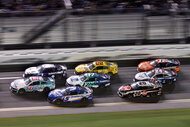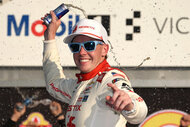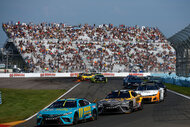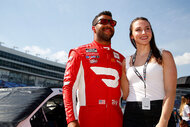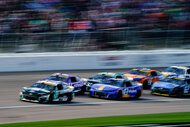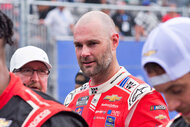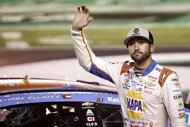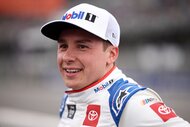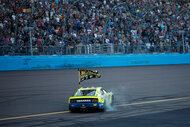How Do NASCAR Drivers And Their Crews Train?
Racing on the NASCAR circuit requires extreme endurance skills, but for pit crews, it's all about strength.

To compete with the best stock car drivers in the world, wheelmen and their crews take their training far more seriously than the average bloke pumping iron at Gold’s Gym, and for good reason. After all, the rigorous demands on these elite athletes tests both their physical and mental fortitude, so keeping their bodies and minds in peak form requires significantly more targeted training than a couple days of bi’s and tri’s. When it comes to NASCAR races, excessive heat, radical G-forces and a constant influx of surging adrenaline is a potentially debilitating combination that would bring us mere mortals to our knees, so how do the best of the best in NASCAR do it? Like all sports, the key, according to Forrest Reynolds of Reynolds Racing, who also grooms up-and-coming drivers, is all in the preparation.
“It’s crazy, you know? It really is a physical sport,” Reynolds told USA Insider. “People don’t realize that when you’re in a car at these short tracks … it really wears you out.”
RELATED: Kyle Larson, Chase Elliott Join Chorus Of NASCAR Drivers Frustrated By Next Gen Cars
“I tell these kids to get into CrossFit – that’s the best overall workout for a driver because of the shoulder work and the cardio work that goes into it,” Reynolds added. “It really seems to give them the strength they need.”
Throttling around banked turns at 200 miles-per-hour for hundreds of laps puts an enormous amount of strain on drivers’ upper arms and shoulders, thus requiring an abundance of what’s referred to as slow-twitch or “Type I” skeletal muscle fibers. In addition to being small in size and fatigue-resistant, these fibers are characterized by having a plethora of capillaries to efficiently deliver blood as well as high levels of myoglobin, an oxygen storage protein, to the muscles. This type of muscle tissue supports the exact type of sustained endurance activity NASCAR drivers face versus fast-twitch or “Type II” skeletal muscle fibers that are integral to power movements such as sprinting or weightlifting. One of the best ways to help assess and monitor this type of muscle endurance comes from drivers wearing heart rate monitors with the goal being for drivers to keep their beats per minute (BPM) under 150.
While NASCAR drivers focus on endurance training, their crewmen – who nowadays often come from various collegiate-level sports backgrounds – take a slightly different approach.
In the blink of an eye, pit crews must pounce on their teams’ cars like a pride of lions on the Serengeti, requiring one person to lug two 48-pound wheels under each arm while the other members split up the strenuous duties of operating a 22-pound jack, a 70-pound fuel can (when full) and an 11-pound pit gun that spins at 15,000 RPM’s and torques around 600 pounds per foot. To properly execute a coordinated pit stop like the four Cup Series crews at Joe Gibbs Racing requires team members to weave in a complex array of total body strength training for four hours, five days a week. Example exercises come in the form of box jumps, squats, sprints and even rope climbs.
While crews may rely on high-weight, low-rep exercises and prolonged strength conditioning to build beefier muscles, Reynolds notes that, for drivers, it’s all about muscle stamina.
“I have had one driver take boxing classes,” Reynolds revealed. “Crossfit is just… A really intense workout on the shoulders, upper body and the cardio. And it’s a competitive environment. I think that’s a big thing too.”
“You get the drivers around other competitive people even at the gym, and they feed off of that,” Reynolds said. “It’s not just joining a gym and going in there and working out by yourself and taking pictures of [yourself] getting cut. If you surround these guys in a competitive atmosphere toward where they want to win even at working out, it transfers over to the racetrack.”
“When it comes down to a tenth of a second per lap,” Reynolds explained, “your physical condition is huge.”
The mental element plays an equally big role in a driver’s success. Persevering through extreme heat and dehydration on the track where drivers can lose up to seven pounds in one race can come down to mind over matter. Then there’s the cerebral element that factors into racing. Besides reviewing countless hours of tape of practice runs and races to diagnose strategic flaws and devise solutions, being a successful NASCAR driver takes passion, grit and a desire to lock-in and tune out all the extraneous noise. It’s not only a career but a lifestyle that is often lonely, pitting friends against friends, or regularly highlighting nemeses. When you’re battling mano a mano against 50 other elite drivers who want nothing more than to see you in their rearview, a healthy diet and proper sleep habits can help keep that killer instinct-level focus intact, but in the end, as Reynolds stated, it often comes down to the will of the human behind the wheel.
“You just have to be fierce – you have to want it really bad – and those are the guys who are going to make it ultimately,” Reynolds noted.
Can't get enough NASCAR action? Watch “Race For The Championship,” which follows the lives of NASCAR's biggest stars on and off the track, Thursdays at 10/9c on USA Network. And catch up on all race action on Peacock.

